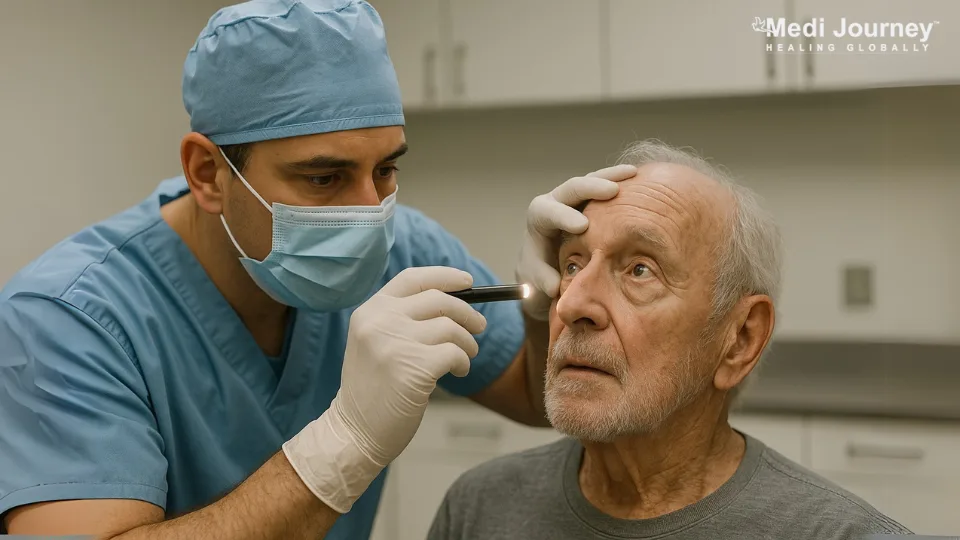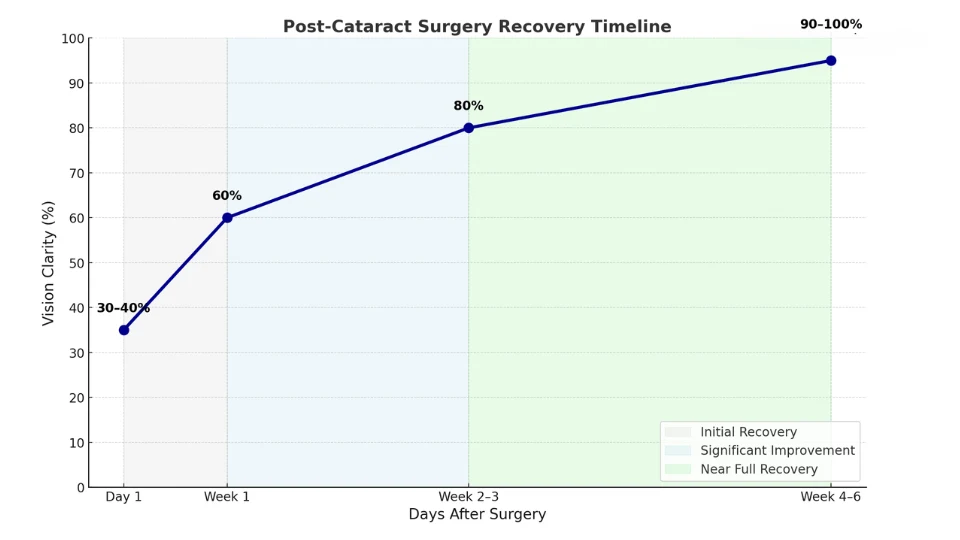Best Cardiologists in Medanta Hospital Gurgaon
 04 December,2025
Read More
04 December,2025
Read More
Enquire now in case of any assistance needed
 07 June,2025
07 June,2025

Cataract surgery is one of the most common surgeries, helping thousands of patients regain clear vision each year. Many believe surgery is safe and effective, yet few truly grasp what occurs during an operation. Even when the procedure is brief and less invasive, some individuals may still feel anxious due to their lack of understanding.
Explaining the details of cataract surgery can help patients feel emotionally prepared for what is to come. The guide explains in detail the different stages, equipment, and methods surgeons use to take out the cloudy lens and improve your vision. Before delving into the details, let's first understand what a cataract is and its associated symptoms.
Fill up the form and get assured assitance within 24 hrs!
When proteins in the eye’s lens stick together, it forms a cataract and prevents light from passing through correctly. The cloudiness in the eye grows worse, resulting in poorer vision over time.
Signs and symptoms that people often report are:
While cataracts cannot be prevented, the power of early detection through regular eye exams cannot be overstated. These exams play a crucial role in identifying cataracts in their early stages, allowing for timely intervention and the best possible outcome. Should surgery be necessary, it remains the only option to improve vision.
Before the operation, various tests and evaluations are performed. When a cataract needs to be removed, you will be given a series of tests.
Both lenticular shapes and types of intraocular lenses (IOLs) may also be discussed during this stage. Types of lenses may include monofocal (for distant vision), multifocal (for both near and distant vision), or toric (for correcting astigmatism).
When deciding on the type of lens, your habits, what you want from life, and your budget are all taken into account. For instance, if you lead an active lifestyle and enjoy outdoor activities, a multifocal lens might be more suitable. If you have a specific budget, we can discuss the options that best fit your financial plan.
You may be required to take certain safety actions, such as:
You usually go home the same day after a 15- to 30-minute cataract surgery. A local anesthetic is administered to ensure you feel no pain during the procedure while staying awake.
Eye drops or a local anesthetic are used before the surgery to numb the eye. It enables you to experience no discomfort during the medical procedure. Gentle pressure from the eyelid speculum will keep your eyelids stretched open, and your doctor will wipe your eye area with sterilized instruments to cut down the risk of infection.
Typically, the surgeon makes a small incision, approximately 2-3 millimeters wide, on the side of the cornea. Such a small incision is closed automatically, so stitches are usually not needed.
An opening is created in the anterior capsule (the front part of the thin, transparent membrane surrounding the lens) so the needle may enter. Now, you can look inside at the cloudy lens.
The surgeon uses ultrasound power to break the lens into many small pieces. From the incision, these pieces are softly suctioned until none are seen. The use of phacoemulsification significantly reduces damage to the eye and results in a faster recovery compared to older approaches.
After the cataract is gone, the surgeon puts the intraocular lens through the original incision. The IOL is removed from its case, placed inside the lens capsule, and carefully adjusted for optimal vision.
Since the cut is very small and the eye stays sealed by pressure, minimal sutures are needed. Very small stitches are sometimes required if the wound is very small.
After cataract surgery, you will spend some time in a recovery area before heading home the same day. It’s normal to feel mild irritation, itching, or watery eyes initially. For several days, your vision may appear hazy or unfocused as your eye heals.
Your cataract surgery doctor might use medicated eye drops or administer medication directly into your eye. You will receive antibiotics and anti-inflammatory eye drops to apply for several weeks, which will help reduce the risk of infection and manage swelling, thereby assisting in the healing process.

This line graph illustrates the progressive improvement in vision clarity after cataract surgery, from 30–40% on Day 1 to 90–100% by Week 6.
Typically, the ophthalmologist will schedule appointments for the day after surgery and 2-4 weeks afterward. These follow-up visits are crucial for monitoring your healing and vision. Your eye pressure will be measured, and any potential issues can be addressed early.
You may get a new glasses prescription once your eye care routine helps stabilize your vision. These visits ensure that you are on the right track to a full recovery and a clear vision.
Although cataract surgery is safe, a few risks may occur:
While it's essential to be aware of potential complications, it's equally important to remember that these are rare and can be effectively managed with prompt medical attention. This knowledge should provide reassurance and alleviate any fears or anxiety you may have about the surgery.
With cataract surgery, medicine has enabled millions to regain clear vision and enjoy a better quality of life. The surgery is performed with precision, causing minimal harm and addressing each patient’s eye problems with the aid of advanced instruments and lens designs. Reviewing the entire process, from pre-surgery to phacoemulsification and lens implantation and, finally, post-surgery, helps patients feel prepared and reassured.
If someone you know has been diagnosed with cataracts, understand that surgery offers them an excellent opportunity to regain clear vision. It is best to consult a qualified ophthalmologist for recommendations on treatment tailored to your eye health and routine.
Regularly visiting an eye doctor is necessary to monitor cataracts and other eye conditions. If you experience any of these symptoms—blurry vision, glare, or trouble driving at night see a specialist promptly. Treating conditions early helps protect your eyesight and maintain your health for many years. If you want to know the Cataract Surgery Cost in India, or are looking for the Best Cataract Surgery Hospitals in India, Visit Medijourney.
Fill up the form and get assured assitance within 24 hrs!
B.Sc in Media Science, NSHM Knowledge Campus, Kolkata, 2019-2022
Suryani Dutta is a passionate content writer with a background in media studies, equipping her with a deep understanding of storytelling, audience engagement, and digital trends.
Dr. Shashidhar TB is an experienced ENT and head and neck surgeon with over 20 years of experience. He specializes in pediatric ENT and has successfully performed numerous surgeries on infants, even in cases where others have failed....
Senior Consultant
Medical Oncologist
Nanavati Super Specialty Hospital, Mumbai
WhatsApp UsSenior Director
Gynecologist and Obstetrician, IVF Specialist
Max Super Speciality Hospital, Shalimar Bagh, New Delhi
WhatsApp UsSenior Director
Gynecologist and Obstetrician, IVF Specialist
Max Smart Super Speciality Hospital, Saket, New Delhi
WhatsApp UsSenior Director
Gynecologist and Obstetrician
Max Smart Super Speciality Hospital, Saket, New Delhi
WhatsApp UsSenior Director
Gynecologist and Obstetrician
Max Smart Super Speciality Hospital, Saket, New Delhi
WhatsApp UsSenior Director
Gynecologist and Obstetrician
Max Smart Super Speciality Hospital, Saket, New Delhi
WhatsApp UsThe Art of Effective Communication
 04 December,2025
Read More
04 December,2025
Read More
 27 November,2025
Read More
27 November,2025
Read More
Trusted by Patients
"I am Asim from Bangladesh and was looking for treatment in India for neuro. I visited many websites to get the complete information regarding the treatment but I was not satisfied as I was getting confused. In the meanwhile, one of my friends suggested I seek help from Medi Journey as he experienced his medical journey very smoothly and was satisfied with it. They have filtered the top 10 doctors as per experience, the success rate of surgery & profile, so it helps us to choose the best treatment in India. "
"For my knee surgery, Medi Journey guided me to BLK Hospital where I received exceptional care. The team's support and the expertise at BLK Hospital exceeded my expectations. Thank you Medi Journey for making my medical journey stress-free. "
"I came from Iraq for my granddaughter's eye surgery in India facilitated by Medi Journey, due to critical cases they advised us to get a second opinion from the different hospitals before going to surgery. Finally, we went to Fortis Escort Hospital, which helped us to get more confidence for diagnosis. Fortis Escort Hospital has the best eye surgeon team with the latest instruments. Thanks to all team members for providing a high-quality treatment in India at an affordable cost. "
"I came for my hair transplant in India, before coming I was so confused about choosing the best clinic and surgeon for me. But thanks to God one of my friends had a hair transplant in India through Medi Journey. He recommended me to go with them. I am completely happy with my experience with them. They were always very fast in their responses to me. the success rate of my hair transplant surgery is 100%."
"Artemis Hospital, suggested by Medi Journey, turned out to be a great choice for my treatment. The personalized assistance and medical care were exceptional. I'm grateful to Medi Journey for guiding me to a hospital that perfectly matched my needs. Highly recommended! "
"I came from Afghanistan for my treatment in India at Jaypee Hospital, Noida. I had a fantastic experience with Medi Journey. Kudos to them for their incredible support during my medical journey. They not only took care of all the logistics but also connected me with a fantastic healthcare team. Efficient, caring, and highly recommended for a hassle-free medical tourism experience."
"I am Adam from Kano, Nigeria, one of my friends from Nigeria was facilitated by Medi Journey, and he recommended us to go with them. I sent my all reports to them and within 48 hours they reverted with 4 options from different hospitals. They helped me to get a Visa letter from the hospital, arrange pick-up from the airport, and book a hotel for me. Their team is very honest and throughout our stay in India they are with us they are caring for us like his family members. BLK Hospital is the best hospital in India with a top surgical oncologist surgeon team, a very advanced OT, and a Radiotherapy department. I wish more success to Medi Journey. "
"Great experience at the Max Hospital for my spine surgery and was successfully done. I thank my neurosurgeon and his entire team. I recommended all of my country's people to Medi Journey for treatment in India, they choose the best hospital, the best doctors, and the best cost for patients."
"I came to India from Dhaka, Bangladesh for my father-in-law's cardiac surgery at Fortis Hospital. I was confused about choosing the best surgeon for him before coming, but their team helped me to choose the best hospital and best cardiac surgeon in India with very good cost and 100% success rate of surgery. I am very happy with the services, really they make my journey so comfortable that make me feel at home. Thanks again and I like people to choose "Medi Journey" as your travel guide. "
"I am Mohammad from Bangladesh came to India for my general health checkup. Medi Journey offers me the complete package including Pick-up from the airport, hotel services, and 24-hour assistance. They guide you to choose the best hospital in India, the best cost of treatment with top-most doctors and give you complete information about hotel booking, and pick-up from the airport before coming to India They have the best team to help. Always choose Medi Journey for your treatment in India."





